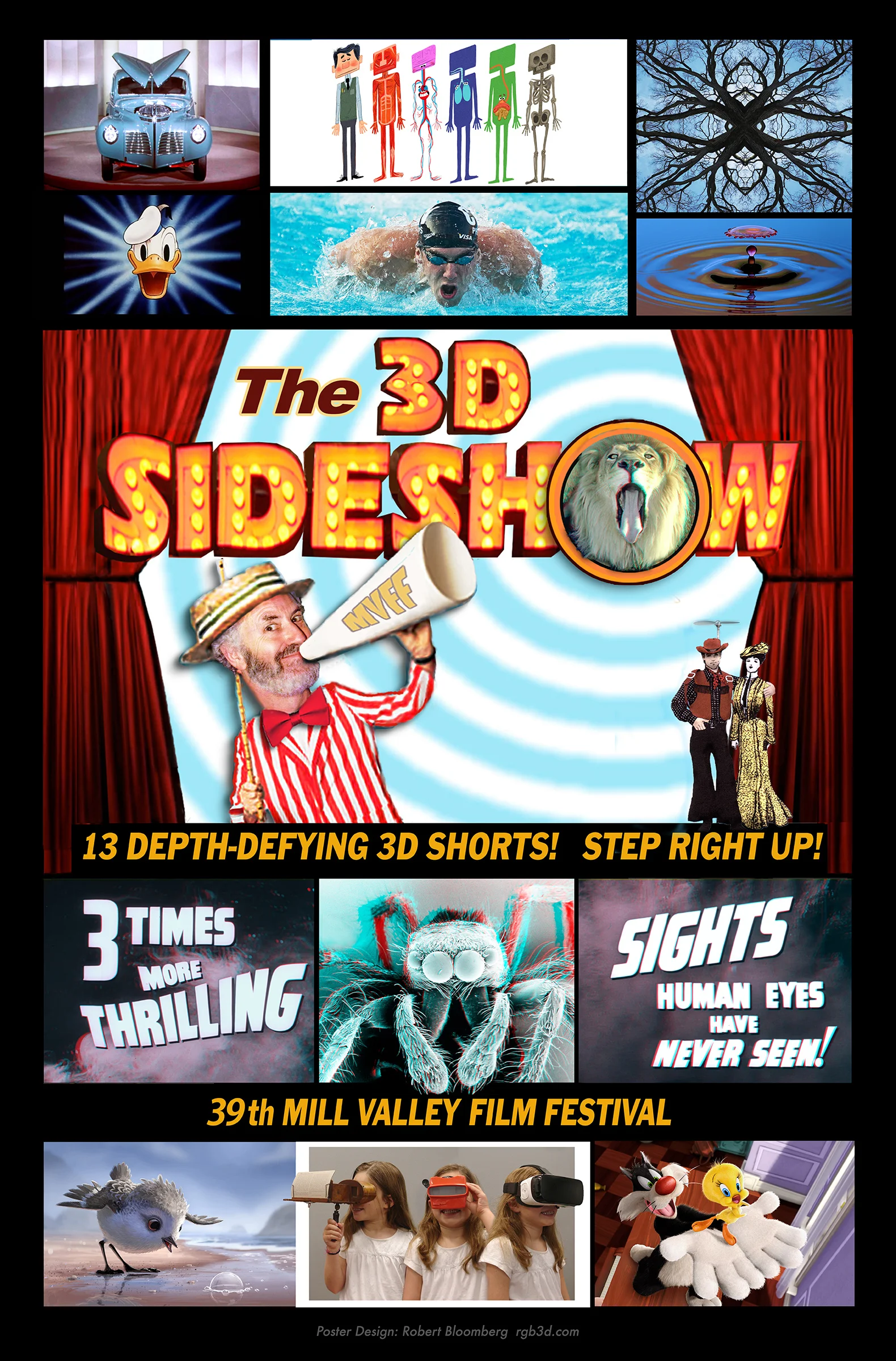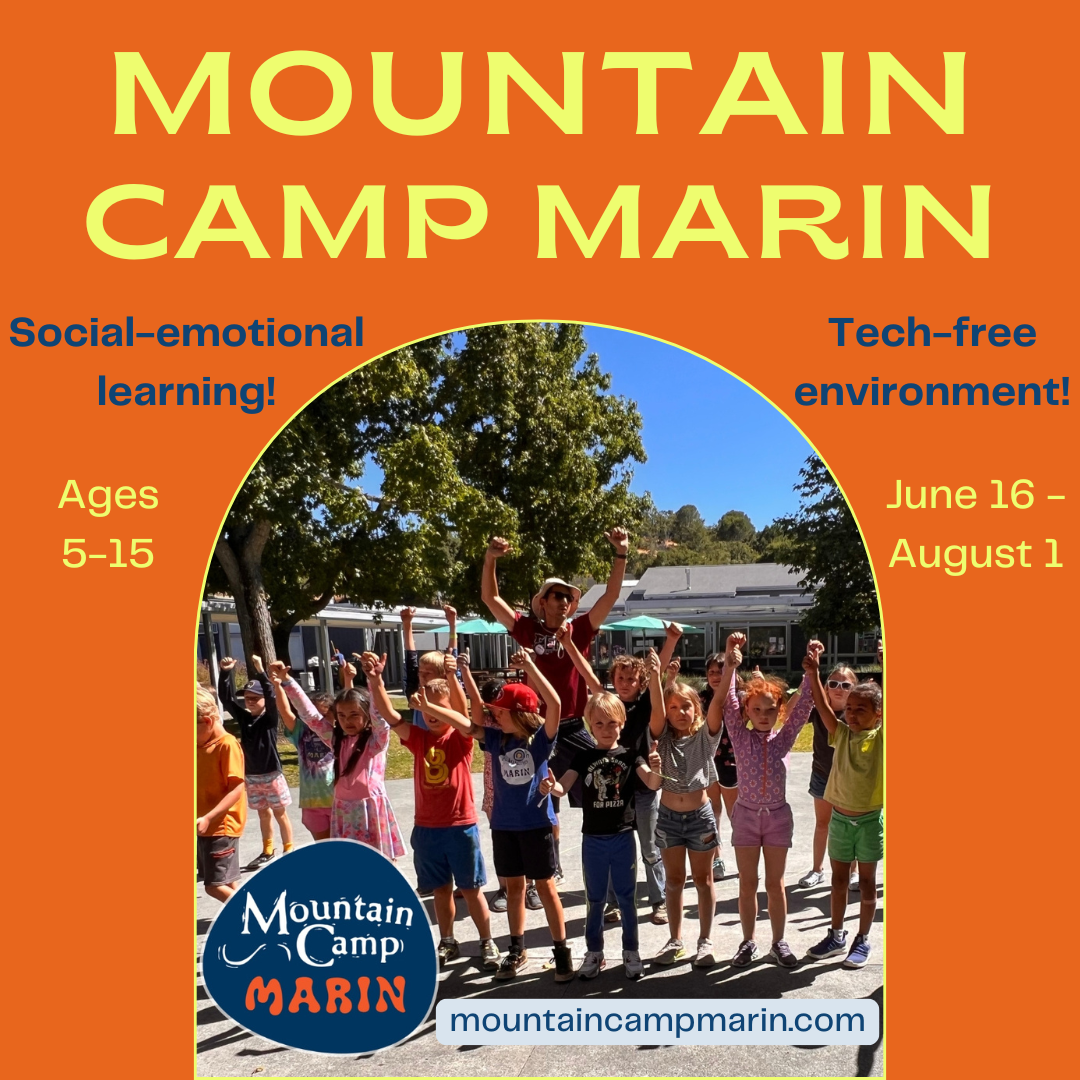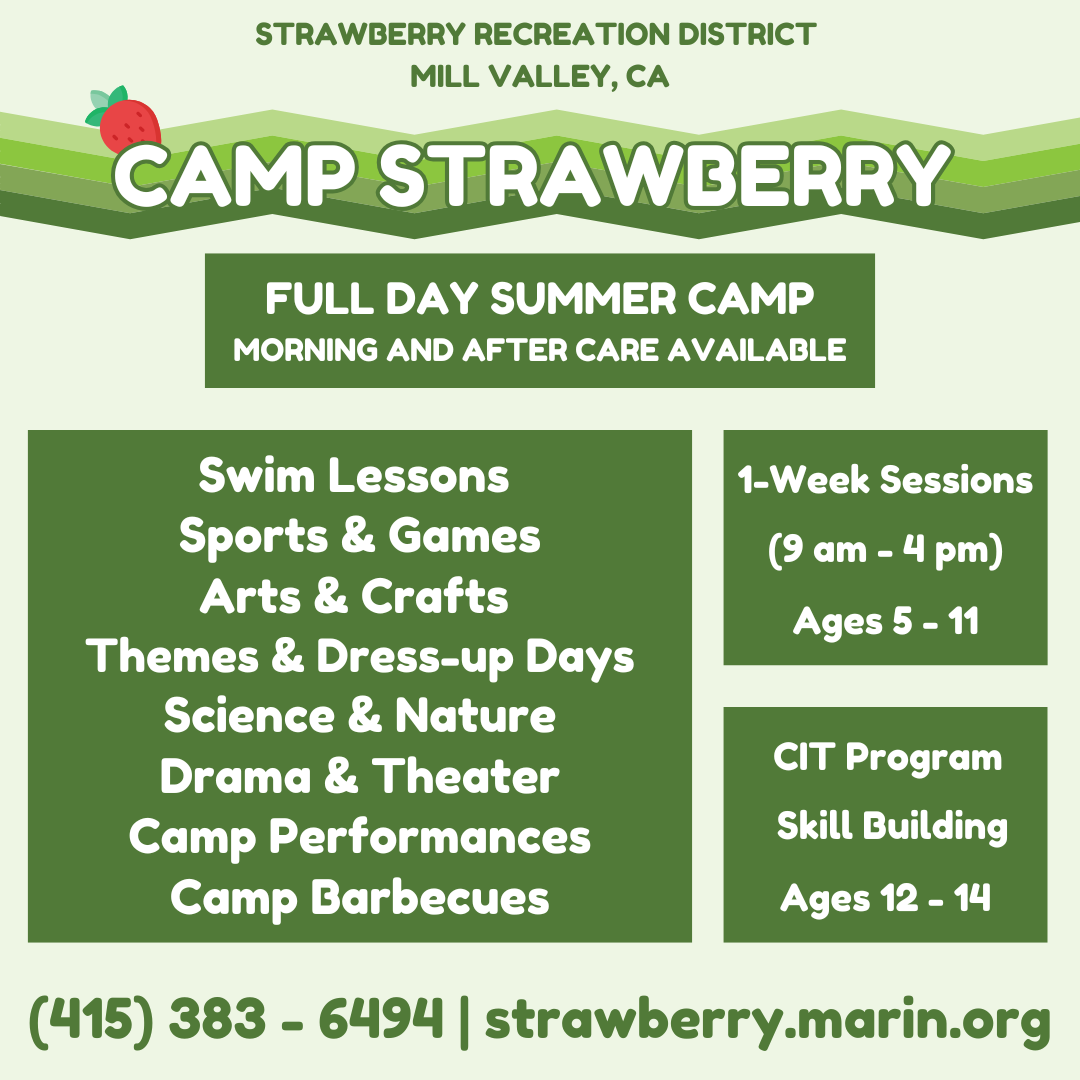Q&A With Robert Bloomberg, Producer Of “The 3D Sideshow”
/The 3D Sideshow
Age Recommendation: 8+
ONLY TWO SHOWS
Sunday, October 9, 12:30pm, Smith Rafael Film Center, San Rafael
Sunday, October 16, 11:15am, Smith Rafael Film Center, San Rafael
* BUY TICKETS *
The 3D Sideshow is one of the many innovative programs showing in the Family Films portion of this years Mill Valley Film Festival. It includes many shorts from around the world in a wide variety of styles. I’m extremely excited to share an exclusive interview with the producer of “The 3D Sideshow” and one of the world’s leading contemporary stereo photographers, Robert Bloomberg.
How did you come up with the idea of the 3D Sideshow?
I’ve been involved with the National Stereoscopic Association (NSA) for decades and was the Northern California director for over 20 years. Each year the NSA hosts a convention called 3DCon, and a main feature of the convention is the Stereo Theater, which showcases the works of both amateur and professional photographers and filmmakers. I thought it was a shame that the general public, especially kids, had little opportunity to see these innovative 3D films. So I had the idea to put together The 3D Sideshow.
Can you tell me more about the variety of shorts a family will experience?
Included in this collection you will see innovative shorts showcasing both big budget films as well as low to no budget films. We’re proud to feature the U.S. 3D premiere of Disney Studio’s newest short, “Inning Workings” and Pixar Studio’s “Piper”, as well as two of their earliest 3D shorts, Disney’s “Working For Peanuts” (1953) and Pixar’s “Knick Knack” (1989), rarely seen in it’s original 3D and featuring an improvised soundtrack by vocal magician Bobby McFerrin.
There is a wide variety of distinctly different approaches to 3D, including computer generated imagery (CGI), hand drawn animation, stop motion, time lapse, as well as live action. There are different genres including music videos like Jeff Boller’s “The Problem With Friends”, and a delightful Warner Bros’ musical short, “I Taut I Taw A Puddy Tat,” (featuring Tweety & Sylvester and the voices of Mel Blanc and June Foray).
What were some of the challenges you faced in bringing this culmination of short films together?
Deciding which films to include in the program was a big challenge. There are so many great films out there, and I wanted to choose not only my favorites, but ones that complimented each other and made for a good program. It’s like planning a dinner party where you want all your guests to get along and have a good time.
Then there was making sure all the films were in the proper format to show on the theater’s projection system. This DCP (Digital Cinema Package) system usually requires expensive conversions by a large production house. Fortunately, there are now several free shareware programs online, such as OpenDCP, which I used to convert those films that were sent to me in other formats.
My 13 year old daughter just signed up to be in the filmmaking club at her middle school. What advice would you give to a kid who aspires to be a filmmaker? Any advice for parents, like myself, to help encourage these future filmmakers/storytellers?
Just keep encouraging them and give them the space to create. If you can afford it, get them equipment and help with whatever they need to pursue their dream, watch their work and be positive. The nice thing about growing up today is that there are so many opportunities, inexpensive software and computers available.
At one time this software and hardware was only available to large studios and was very expensive. Now, people are shooting movies with iPhones and editing movies on their laptops.
Also, watching films together with your kids, talking about them, the editing, camera positions, sound and music, etc. The more films you see with your kids, the more you can talk about them in that way. Ask what they think makes them good, what they don't like about them, and help them look at what they’re watching more critically.
As a parent, I worry about my child getting into 3D because I don't want her on the computer all the time. How can a parent, like myself, help encourage this interest without feeling like she is spending too much time on the computer?
I'm old school in terms of filmmaking. The last film I did for the Mill Valley Film Festival was “How to Draw a Cat” which I did in my living room with a one man- one cat crew. Ask what she is interested in and what is out there in the world that she would like to share with other people. Perhaps she likes visiting the animals at WildCare or enjoys a particular sport or activity; this could be the perfect subject for her film. That way she is out there and not sitting in front of a computer but engaging with a subject she’s excited about. These days the computer is a necessary part of the process for editing, but the actual experience of making and sharing the film doesn't have to involve sitting in front of a computer all day.
Although 3D has been around for a long time it was not fully embraced by movie studios – it was a novelty. I remember seeing "Jaws 3" with 3D glasses I got off the back of a cereal box. Now with computer technology, many films seem to get caught up in 3D - especially kids films. Do you see this trend continuing?
Unfortunately, there is a lot of prejudice about 3D because of its hit and miss history. It was often done by people who really didn't understand the 3D process or care enough about the final product to put the effort in. It does require attention to detail. In the past there were limitations with technology. The big 3D films in the 50's involved having 2 projectors lined up on the screen in exact registration and synchronization. The sad fact was many of the projectionists were not trained or familiar with the process.
How does 3D change the type of story you can tell?
Movie making is fairly young, only a little over 120 years old, and filmmakers have had a chance to experiment and learn their craft and develop a film language. 3D has existed in some form since 1915 but filmmakers haven’t had the time to develop the language of 3D filmmaking they way they have with 2D. To me, Avatar was the first big 3D success because James Cameron is interested in doing 3D the right way. Now, several Academy Awards have gone to both animated and feature films in 3D. Films like "Life of Pi" and “Hugo" and prominent directors like Ang Lee and Martin Scorsese are using 3D in an intelligent way, and not just using it as a gimmick. Ideally, 3D should become a natural thing so that people don’t even think about it. For me, I have to ask “Is 3D important for the subject?” You have to have a reason for using it.
How does 3D lend itself to the overall experience of the 3D Sideshow that you would not get from 2D?
We see in 3D. Everyone is walking around shooting 3D all the time. Your 2 eyes are like 2 lenses of a camera that your brain is fusing into 3D. So it's a natural way of seeing the world. Hopefully in the near future you won’t be thinking about whether a film is in 3D or 2D, the way you don’t think about a film being in color as opposed to black and white. 3D can really add to a film. In Werner Herzog's film, “Cave of Forgotten Dreams” the 3D lets the audience see how prehistoric painters incorporated the surface of the cave into their art. 3D brings you into their world, and makes it so much more immersive.
I know some people interested in having their film in the Mill Valley Film Festival. What can you tell my audience about the process of getting a film into the Mill Valley Film Festival?
Just send it in. In my case, I was encouraged by a friend to submit my “How To Draw a Cat”, so I sent an email with a description of film, posted a video online for them to view, and it ended up being selected for showing by the festival. One of the nice aspects of the Mill Valley Film Festival is their interest in and support of local filmmakers.
Is this compilation of shorts going to be shown anywhere else?
No, these two screenings will be the only opportunity to see this particular compilation of films. This is the second “3D SideShow”. I would love to see it run as a yearly event, similar to John Goddard’s wonderful “Hi De Ho Show.” There were so many great shorts I had to cut out because of time restrictions and I would love a chance to showcase them in the future.
Can you give me some insight on what surprises audience members will experience?
On October 9th the director of Disney’s “Inner Workings” will introduce the film and participate in a Q & A following the program. I will also be participating in the Q&A, as well as Academy Award-winning filmmaker Franklin Londin whose “3Deee Mirrors” is featured in the program.
On October 16th we will have the filmmakers from Pixar who made “Piper” introducing the film and participating in a Q&A following the show.
We will also have a special door prize giveaway at both screenings of a wonderful new 3D product.
Many young people today are interested in learning 3D. We have camps and classes for kids in elementary school who are interested in learning 3D. Any last bits of advice for young artists just embarking on 3D as a potential path of interest?
There are so many tutorials online, How-to's, equipment and DIY projects available. The National Stereoscopic Association has a magazine which has great articles. There are local film groups such as The Oakland Camera Club, which has a 3D division, festivals such as Mill Valley that supports and shows 3D. They have a wonderful program, CFI Education which encourages young filmmakers. I’m sure if your daughter came up with an interesting film, they would definitely take a look at it.
Also there are several 3D smartphone Apps, such as i3DSteroid and 3D Camera, that make it fast and simple to produce 3D that you can share online or email to a friend. The technology these days is so amazing.
Where do you see this technology going?
I think it is just going to become easier for everyone to create art. There is hardly anywhere you can go in the world these days where people are not shooting photos and videos. I can’t think of a single major event that doesn't get recorded. It's just a matter of having the vision and taking the time to put it together. It's one thing to shoot—there are so many people out there with thousands of photos and movies on their computer—it’s another thing to take that raw material and create something special. That is the hard part and where the work comes in, but it can be the most rewarding. For me, it’s a way to combine all mypassions.
The Mill Valley Film Festival runs October 6-16. In addition to the 3D Sideshow, this years children’s selection features innovative family films including a FREE outdoor screening of "Inside Out" at the Old Mill Park in Mill Valley and a exclusive selection of family-freindly films including Kepler's Dream, Miss Hokusai, Molly Monster, Oddball, 5@5, and the MVFF Youth Reel. PLUS a screening of the Star Wars Trilogy to commemorate the final days of the Century Cinema at Corte Madera.
For a free pair of 3D glasses, mail a SASE to Box 227, Forest Knolls, CA 94933. You can use them to better view the images on Robert's website.
ABOUT THE MILL VALLEY FILM FESTIVAL
For nearly four decades, the world-renowned Mill Valley Film Festival (MVFF) has maintained its position as a vital showcase of the global film community, attracting iconic red-carpet talent, burgeoning filmmakers, passionate audiences, and astutely curated premieres. An in-demand destination for film lovers, drawn by unmatched locale and a diverse program of mainstream studio features and new visions from independent voices from around the world, MVFF also hosts an exciting array of filmmaker and industry conversations, panels, parties, and live music Find out more on their website, Twitter, Instagram, and Facebook.

















